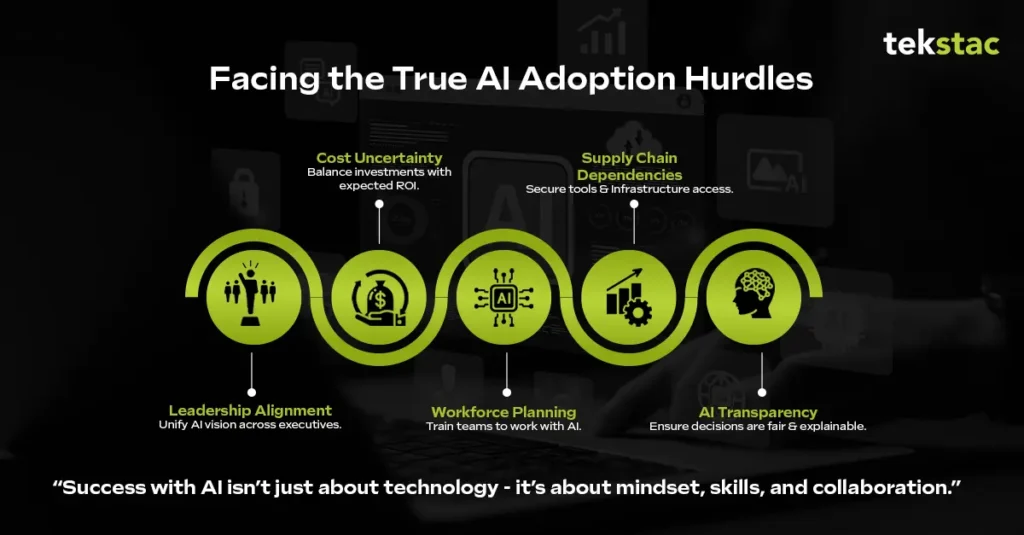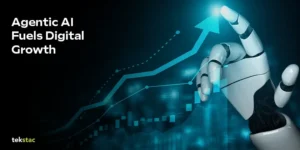From Hype to Impact: Making AI Work for Your Business
April 17, 2025

Based on the McKinsey report “Superagency in the Workplace – Empowering People to Unlock AI’s Full Potential”
AI Work Begins Now: Are You Ready?
Artificial Intelligence (AI) is no longer a futuristic vision, it is here, reshaping industries at an unprecedented pace. Much like the steam engine revolutionized production during the Industrial Revolution, AI has the potential to redefine work, productivity, and economic growth. However, despite 92% of organizations planning to increase AI investments over the next three years, only 1% consider themselves AI-mature.
The key roadblock? Leadership readiness.
Organizations must move beyond small-scale AI initiatives and embrace bold AI-driven transformations to maintain a competitive edge.
AI: A Workplace Game Changer
AI is no longer just about automation; it is enabling smarter decision-making, problem-solving, and operational efficiency across industries. Generative AI alone is projected to generate $4.4 trillion in productivity gains. Yet, despite these promising numbers, many companies hesitate to move beyond the pilot phase of AI implementation.
Forward-thinking businesses understand that AI can:
- Enhance operational efficiency and decision-making.
- Improve customer experiences through personalized interactions.
- Drive innovation by identifying market trends and optimizing business strategies.
The question is not whether companies should adopt AI but how effectively they can deploy it at scale.
The Leadership Gap: Are Employees Ahead of the Curve?
One of the most striking findings of the MC Kinsey report is that employees are adopting AI faster than leaders anticipate:
- Three times more employees use AI in their daily tasks than executives estimate.
- 70% of employees believe AI will significantly alter at least 30% of their work within two years.
- Only 20% of leaders foresee AI transforming workflows in the near future.
This misalignment presents a major challenge. Employees are ready for AI-driven change, but leadership hesitancy is slowing progress. Organizations need to bridge this gap by educating leaders, fostering AI-friendly workplace cultures, and integrating AI into strategic planning.
A critical piece of this puzzle is investing in learning and skilling programs that empower both employees and leaders to understand, adapt to, and fully leverage AI technologies.
This is where platform like Tekstac play a pivotal role to integrates AI-driven personalized learning, assessments, and skill development into the workplace. By aligning learning paths with role-specific needs, Tekstac helps individuals and organizations build the AI fluency required to lead transformation, not just follow it.
Whether it’s through simulated assessments, AI-proctored environments, or performance dashboards, we ensures continuous upskilling aligned with evolving industry demands.
Speed vs. Safety: Navigating AI Risks
With AI adoption comes responsibility. Businesses must balance the rapid deployment of AI with concerns around cybersecurity, bias, and ethical decision-making.
Key concerns include:
- Cybersecurity risks –51% of employees cite security vulnerabilities as their top AI concern.
- AI bias and fairness – Organizations must ensure AI models are transparent and equitable.
- AI explainability – Businesses need AI systems that provide clear, logical justifications for their decisions.
To mitigate these risks, organizations should implement robust AI governance frameworks, establish ethical benchmarks, and ensure compliance with data privacy regulations.
Moving Beyond Incremental Change: The Need for Bold AI Ambitions
Many companies take a cautious approach to AI, experimenting with small-scale projects rather than fully embedding AI into their core operations. However, true transformation requires bold AI ambitions. Industries such as healthcare, finance, and retail are already seeing the benefits of large-scale AI integration:
- Healthcare – AI-driven drug discovery and personalized treatment plans.
- Finance – AI-powered fraud detection and predictive analytics.
- Retail – AI-driven demand forecasting and customer insights.
Organizations that continue treating AI as an auxiliary tool rather than a fundamental part of their business model risk falling behind.
The Real Challenge: Organizational Readiness, Not Technology
Despite the rapid advancement of AI technology, organizations face several operational challenges when it comes to AI adoption. The report highlights five major hurdles:

- Leadership alignment – Executives must develop a unified AI vision.
- Cost uncertainty – AI investments should be balanced with long-term ROI expectations.
- Workforce planning – Employees must be trained to work alongside AI rather than fear job displacement.
- Supply chain dependencies – Businesses need access to the right AI tools and infrastructure.
- AI transparency – AI-driven decisions must be understandable and unbiased.
Overcoming these challenges requires strategic planning, cross-functional collaboration, and a commitment to continuous learning and adaptation.
Here are the critical takeaways from McKinsey’s findings:
Leadership inertia is the bottleneck
While 92% of companies plan to increase AI investments, only 1% consider themselves AI-mature—largely because leadership hasn’t aligned on bold, long-term AI strategies.
Employees are ahead of the curve
There’s a striking mismatch between executive perception and employee reality: three times more employees are using AI than leaders estimate, and 70% expect AI to significantly reshape their work within two years.
Ethical and secure AI is non-negotiable
As organizations scale AI, concerns around cybersecurity, data privacy, and algorithmic bias must be actively addressed. AI governance, explainability, and fairness should be foundational—not afterthoughts.
Small pilots are not enough
To unlock transformative value, businesses must move beyond incremental efforts and fully embed AI into their core workflows, products, and services.
Skilling is a strategic lever
Organizational capability depends on a well-trained, AI-literate workforce that includes both frontline employees and C-suite leaders.
Conclusion: The Road to AI Maturity
AI presents limitless opportunities, but only organizations that act decisively will unlock its full potential. Leaders must step up, align AI strategies with business objectives, and foster AI-literate workplaces.
To succeed in the AI-driven future, businesses must:
- Invest in AI training for employees and leadership alike.
- Implement ethical AI governance to ensure responsible AI use.
- Scale AI adoption beyond experimental phases to drive tangible business impact.
- Embrace bold AI ambitions that transform workflows and create new opportunities.
AI is no longer optional; it is an imperative. The time to act is now. Organizations that leverage AI strategically will not only stay competitive but also redefine the future of work.





